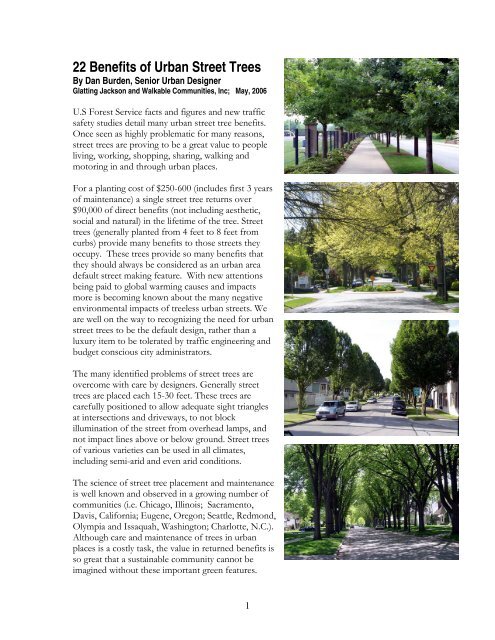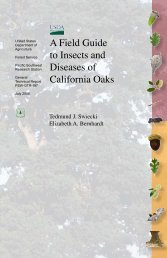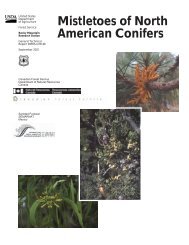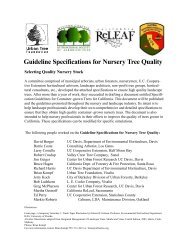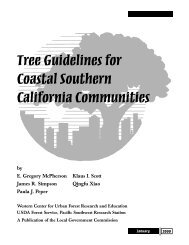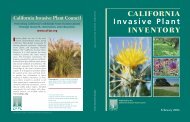22 Benefits of Urban Street Trees (1 MG PDF) - Northland NEMO
22 Benefits of Urban Street Trees (1 MG PDF) - Northland NEMO
22 Benefits of Urban Street Trees (1 MG PDF) - Northland NEMO
Create successful ePaper yourself
Turn your PDF publications into a flip-book with our unique Google optimized e-Paper software.
<strong>22</strong> <strong>Benefits</strong> <strong>of</strong> <strong>Urban</strong> <strong>Street</strong> <strong>Trees</strong><br />
By Dan Burden, Senior <strong>Urban</strong> Designer<br />
Glatting Jackson and Walkable Communities, Inc; May, 2006<br />
U.S Forest Service facts and figures and new traffic<br />
safety studies detail many urban street tree benefits.<br />
Once seen as highly problematic for many reasons,<br />
street trees are proving to be a great value to people<br />
living, working, shopping, sharing, walking and<br />
motoring in and through urban places.<br />
For a planting cost <strong>of</strong> $250-600 (includes first 3 years<br />
<strong>of</strong> maintenance) a single street tree returns over<br />
$90,000 <strong>of</strong> direct benefits (not including aesthetic,<br />
social and natural) in the lifetime <strong>of</strong> the tree. <strong>Street</strong><br />
trees (generally planted from 4 feet to 8 feet from<br />
curbs) provide many benefits to those streets they<br />
occupy. These trees provide so many benefits that<br />
they should always be considered as an urban area<br />
default street making feature. With new attentions<br />
being paid to global warming causes and impacts<br />
more is becoming known about the many negative<br />
environmental impacts <strong>of</strong> treeless urban streets. We<br />
are well on the way to recognizing the need for urban<br />
street trees to be the default design, rather than a<br />
luxury item to be tolerated by traffic engineering and<br />
budget conscious city administrators.<br />
The many identified problems <strong>of</strong> street trees are<br />
overcome with care by designers. Generally street<br />
trees are placed each 15-30 feet. These trees are<br />
carefully positioned to allow adequate sight triangles<br />
at intersections and driveways, to not block<br />
illumination <strong>of</strong> the street from overhead lamps, and<br />
not impact lines above or below ground. <strong>Street</strong> trees<br />
<strong>of</strong> various varieties can be used in all climates,<br />
including semi-arid and even arid conditions.<br />
The science <strong>of</strong> street tree placement and maintenance<br />
is well known and observed in a growing number <strong>of</strong><br />
communities (i.e. Chicago, Illinois; Sacramento,<br />
Davis, California; Eugene, Oregon; Seattle, Redmond,<br />
Olympia and Issaquah, Washington; Charlotte, N.C.).<br />
Although care and maintenance <strong>of</strong> trees in urban<br />
places is a costly task, the value in returned benefits is<br />
so great that a sustainable community cannot be<br />
imagined without these important green features.<br />
1
Properly placed and spaced urban street trees<br />
provide these benefits:<br />
Increased motorized traffic and pedestrian safety<br />
(contrary to popular myths). See below article for<br />
details on mode safety enhancements. See<br />
especially the compilation <strong>of</strong> safety benefits<br />
detailed in, Safe <strong>Street</strong>s, Livable <strong>Street</strong>s, by Eric<br />
Dumbaugh Journal <strong>of</strong> the American Planning<br />
Association, Vol. 71, No. 3, Summer 2005. One<br />
such indication <strong>of</strong> increased safety with urban<br />
street trees is quoted from this document:<br />
“Indeed, there is a growing body <strong>of</strong> evidence suggesting that the<br />
inclusion <strong>of</strong> trees and other streetscape features in the roadside<br />
environment may actually reduce crashes and injuries on urban<br />
roadways. Naderi (2003) examined the safety impacts <strong>of</strong><br />
aesthetic streetscape enhancements placed along the roadside and<br />
medians <strong>of</strong> five arterial roadways in downtown Toronto. Using a<br />
quasi-experimental design, the author found that the inclusion <strong>of</strong><br />
features such as trees and concrete planters along the roadside<br />
resulted in statistically significant reductions in the number <strong>of</strong><br />
mid-block crashes along all five roadways, with the number <strong>of</strong><br />
crashes decreasing from between 5 and 20% as a result <strong>of</strong> the<br />
streetscape improvements. While the cause for these reductions is<br />
not clear, the author suggests that the presence <strong>of</strong> a well defined<br />
roadside edge may be leading drivers to exercise greater caution.”<br />
1. Reduced and more appropriate urban<br />
traffic speeds. <strong>Urban</strong> street trees create<br />
vertical walls framing streets, and a<br />
defined edge, helping motorists guide<br />
their movement and assess their speed<br />
(leading to overall speed reductions).<br />
<strong>Street</strong> safety comparisons show a<br />
reduction <strong>of</strong> run-<strong>of</strong>f-the-road crashes and<br />
overall crash severity when street tree<br />
sections are compared with equivalent<br />
treeless streets. (Texas A and M<br />
conducted simulation research which<br />
found people slow down while driving<br />
through a treed scape. These observations<br />
are also noted in the real world when<br />
following motorists along first a treed<br />
portion <strong>of</strong> a street, and then a non treed<br />
portion. Speed differentials <strong>of</strong> 3 mph to<br />
15 mph are noted.<br />
2
2. Create safer walking environments, by<br />
forming and framing visual walls and<br />
providing distinct edges to sidewalks so that<br />
motorists better distinguish between their<br />
environment and one shared with people. If<br />
a motorist were to significantly err in their<br />
urban driving task, street trees can deflect or<br />
fully stop a motorist from taking another<br />
human life.<br />
3. <strong>Trees</strong> call for planting strips, which<br />
further separate motorists from pedestrians,<br />
buildings and other urban fabric.<br />
4. Increased security. <strong>Trees</strong> create more<br />
pleasant walking environments, bringing<br />
about increased walking, talking, pride, care<br />
<strong>of</strong> place, association and therefore actual<br />
ownership and surveillance <strong>of</strong> homes,<br />
blocks, neighborhoods plazas, businesses<br />
and other civic spaces.<br />
5. Improved business. Businesses on<br />
treescaped streets show 20% higher income<br />
streams, which is <strong>of</strong>ten the essential<br />
competitive edge needed for main street<br />
store success, versus competition from<br />
plaza discount store prices.<br />
6. Less drainage infrastructure. <strong>Trees</strong><br />
absorb the first 30% <strong>of</strong> most precipitation<br />
through their leaf system, allowing<br />
evaporation back into the atmosphere. This<br />
moisture never hits the ground. Another<br />
percentage (up to 30%) <strong>of</strong> precipitation is<br />
absorbed back into the ground and taken in<br />
and held onto by the root structure, then<br />
absorbed and then transpired back to the<br />
air. Some <strong>of</strong> this water also naturally<br />
percolates into the ground water and<br />
aquifer. Storm water run<strong>of</strong>f and flooding<br />
potential to urban properties is therefore<br />
reduced.<br />
3
7. Rain, sun, heat and skin protection.<br />
For light or moderate rains, pedestrians<br />
find less need for rain protection. In cities<br />
with good tree coverage there is less need<br />
for chemical sun blocking agents.<br />
Temperature differentials <strong>of</strong> 5-15 degrees<br />
are felt when walking under tree canopied<br />
streets.<br />
8. Reduced harm from tailpipe<br />
emissions. Automobile and truck exhaust<br />
is a major public health concern and<br />
contains significant pollutants, including<br />
carbon monoxide (CO), volatile organic<br />
compounds (VOC), nitrogen oxides<br />
(NOx), and particulate matter (PM).<br />
Tailpipe emissions are adding to asthma,<br />
ozone and other health impacts. Impacts<br />
are reduced significantly from proximity<br />
to trees.<br />
9. Gas transformation efficiency. <strong>Trees</strong> in<br />
street proximity absorb 9 times more<br />
pollutants than more distant trees,<br />
converting harmful gasses back into<br />
oxygen and other useful and natural<br />
gasses.<br />
10. Lower urban air temperatures. Asphalt<br />
and concrete streets and parking lots are<br />
known to increase urban temperatures 3-7<br />
degrees. These temperature increases<br />
significantly impact energy costs to<br />
homeowners and consumers. A properly<br />
shaded neighborhood, mostly from urban<br />
street trees, can reduce energy bills for a<br />
household from 15-35%.<br />
11. Lower Ozone. Increases in urban street<br />
temperatures that hover directly above<br />
asphalt where tailpipe emissions occur<br />
dramatically increase creation <strong>of</strong> harmful<br />
ozone and other gasses into more noxious<br />
substances impacting health <strong>of</strong> people,<br />
animals and surrounding agricultural<br />
lands.<br />
4
12. Convert streets, parking and walls into<br />
more aesthetically pleasing environments.<br />
There are few streetmaking elements that do<br />
as much to s<strong>of</strong>ten wide, grey visual wastelands<br />
created by wide streets, parking lots and<br />
massive, but sometimes necessary blank walls<br />
than trees.<br />
13. S<strong>of</strong>ten and screen necessary street features<br />
such as utility poles, light poles and other<br />
needed street furniture. <strong>Trees</strong> are highly<br />
effective at screening those other vertical<br />
features to roadways that are needed for many<br />
safety and functional reasons.<br />
14. Reduced blood pressure, improved overall<br />
emotional and psychological health.<br />
People are impacted by ugly or attractive<br />
environments where they spend time.<br />
Kathlene Wolf, Social Science Ph.D.<br />
University <strong>of</strong> Washington gave a presentation<br />
that said “the risk <strong>of</strong> treed streets was<br />
questionable compared to other types <strong>of</strong><br />
accidents along with the increased benefit <strong>of</strong><br />
trees on human behavior, health, pavement<br />
longevity, etc.” She noted that trees have a<br />
calming and healing effect on ADHD adults<br />
and teens.<br />
15. Time in travel perception. Other research<br />
and observations confirm that motorists<br />
perceive the time it takes to get through treed<br />
versus non-treed environments has a<br />
significant differential. A treeless environment<br />
trip is perceived to be longer than one that is<br />
treed (Walter Kulash, P.E.; speech circa 1994,<br />
Glatting Jackson).<br />
16. Reduced road rage. Although this may at<br />
first seem a stretch, there is strong,<br />
compelling research that motorist road rage is<br />
less in green urban versus stark suburban<br />
areas. <strong>Trees</strong> and aesthetics, which are known<br />
to reduce blood pressure, may handle some <strong>of</strong><br />
this calming effect.<br />
5
17. Improved operations potential. When<br />
properly positioned and maintained, the<br />
backdrop <strong>of</strong> street trees allow those features<br />
that should be dominant to be better seen, such<br />
as vital traffic regulatory signs. The absence <strong>of</strong> a<br />
well developed Greenscape allows the sickly<br />
grey mass <strong>of</strong> strip to dominate the visual world.<br />
At the same time, poorly placed signs, signals,<br />
or poorly maintained trees reduces this positive<br />
gain, and thus proper placement and<br />
maintenance must be rigidly adhered to.<br />
18. Added value to adjacent homes, businesses<br />
and tax base. Realtor based estimates <strong>of</strong> street<br />
tree versus non street tree comparable streets<br />
relate a $15-25,000 increase in home or<br />
business value. This <strong>of</strong>ten adds to the base tax<br />
base and operations budgets <strong>of</strong> a city allowing<br />
for added street maintenance. Future economic<br />
analysis may determine that this is a break-even<br />
for city maintenance budgets.<br />
19. Provides a lawn for a splash and spray<br />
zone, storage <strong>of</strong> snow, driveway elevation<br />
transition and more. Tree lawns are an<br />
essential part <strong>of</strong> the operational side <strong>of</strong> a street.<br />
20. Filtering and screening agent. S<strong>of</strong>tens and<br />
screens utility poles, light poles, on-street and<br />
<strong>of</strong>f-street parking and other features creating<br />
visual pollution to the street.<br />
21. Longer pavement life. Studies conducted in a variety <strong>of</strong> California environments<br />
show that the shade <strong>of</strong> urban street trees can add from 40-60% more life to costly<br />
asphalt. This factor is based on reduced daily heating and cooling<br />
(expansion/contraction) <strong>of</strong> asphalt. As peak oil pricing increases roadway overlays,<br />
this will become a significant cost reduction to maintaining a more affordable<br />
roadway system.<br />
<strong>22</strong>. Connection to nature and the human senses. <strong>Urban</strong> street trees provide a<br />
canopy, root structure and setting for important insect and bacterial life below the<br />
surface; at grade for pets and romantic people to pause for what pets and romantic<br />
people pause for; they act as essential l<strong>of</strong>ty environments for song birds, seeds, nuts,<br />
squirrels and other urban life. Indeed, street trees so well establish natural and<br />
comfortable urban life it is unlikely we will ever see any advertisement for any<br />
marketed urban product, including cars, to be featured without street trees making<br />
the ultimate dominant, bold visual statement about place.<br />
6


